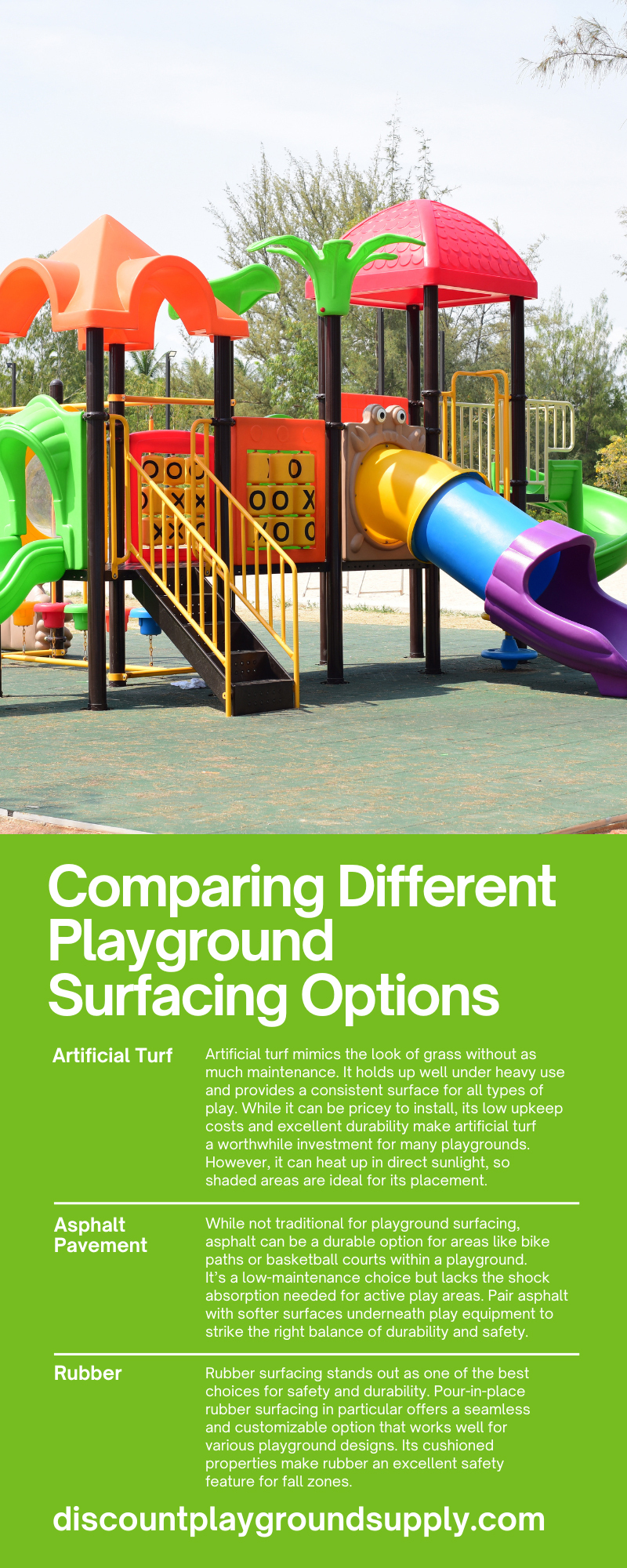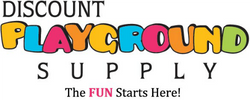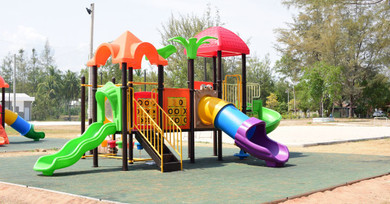A playground is home to nearly limitless possibilities. Running from the slide to the swings, the children of your community don’t care if the surface under their feet is mulch or rubber. Their imagination easily transforms it into the open ocean on which their pirate ship sails or the tops of clouds as they pretend to fly.
To you, however, comparing different playground surfacing options couldn’t be more important. This is a choice that will determine the safety, maintenance, and longevity of the playground. So, let’s take a closer look at some of the most popular options and see how they measure up.
Why Does Playground Surfacing Matter?
Whether you’re planning a new playground or upgrading an old one, choosing the right surfacing is one of the most important decisions you’ll make.
Playground surfacing serves a bigger purpose than just aesthetics; it’s fundamental to the usability and safety of the space. While children run, jump, and climb, the surfacing below them acts as a safety net, cushioning falls and reducing injuries.
In addition, high-quality surfacing can endure heavy foot traffic, harsh weather conditions, and regular wear and tear. This durability ensures that the playground remains safe, functional, and visually appealing over time.
Which Factors Should You Compare?
Finding the right surfacing option for your playground takes careful consideration. Make sure to base your decision on the right criteria.
Aesthetic Appeal
A well-thought-out surface can tie together the entire design and make the playground more visually appealing. Natural elements like grass and sand bring an organic feel, while artificial turf or colorful rubber tiles add a polished, modern touch.
Price Point
You likely have a budget you need to stick to when planning your playground. While options like dirt or pea gravel might seem cost-effective upfront, they can lead to higher maintenance costs over time. On the other hand, investing in rubber surfacing may cost more initially but offers durability and lower long-term upkeep, saving you money down the road.
Ease of Installation
Certain surfaces are easier to install than others. Materials like wood chips or gravel easily spread and don’t require specialized equipment or extensive labor. However, more elaborate options such as artificial turf often require professional installation.
Ease of Maintenance
Of course, your work doesn’t end when the playground is set up. Maintenance plays a key role in keeping the playground safe and enjoyable for kids. Choosing materials that are easy to maintain can save time and resources in the long run.
While options like dirt or grass may wear out quickly and need constant care, materials like rubber tiles and artificial turf will last a long time with minimal upkeep, making them perfect for busy, high-traffic areas.
Safe Space for Children
[Image A]
Safety is the primary concern when choosing playground surfacing. Falls are the most common source of playground injuries, making cushioning materials essential. Surfaces like rubber and grass are excellent for minimizing fall-related injuries, while harder surfaces like asphalt may not provide enough shock absorption for safe play.
What Natural Elements Can Be Used for Playground Surfacing?
When comparing different playground surfacing options, you may want to consider natural elements. Here is an overview of your options.
Grass
Grass provides a natural, lush aesthetic that’s hard to beat. It’s soft underfoot, budget-friendly, and offers a cooling effect on hot days, making it a great choice for outdoor spaces.
However, grass often struggles to withstand heavy foot traffic, leaving patches of dirt and mud in frequently used areas. Additionally, regular mowing and watering are necessary to maintain its appearance and usability.
Dirt
Using dirt as playground surfacing is a minimal-cost solution requiring little to no installation. However, dirt quickly becomes uneven and compacted, making it less safe and prone to puddling after rain. It’s often best suited as a temporary solution rather than a long-term option.
Sand
Sand has been a playground staple for decades due to its affordability and cushioning properties. Children love playing in it, but it tends to scatter easily and can be uncomfortable on hot days. Regular refilling and raking are essential to keep sand in good condition.
Pea Gravel
Pea gravel provides a natural yet structured look for playgrounds. It’s durable and easy to install, but like sand, it may scatter over time. Additionally, pea gravel doesn’t offer the same cushioning properties as other surfaces, making it less ideal for fall zones.
Wood Chips
Wood chips are a popular, eco-friendly option for playground surfacing. They’re relatively affordable and provide a fair amount of cushioning. However, they can decay, compact, or scatter, requiring occasional replenishment to stay effective.
What Other Options Are There for Good Playground Surfacing?
For those seeking durability and consistent performance, there are several modern alternatives to natural surfaces that bring both safety and visual appeal to playgrounds.
Artificial Turf
Artificial turf mimics the look of grass without as much maintenance. It holds up well under heavy use and provides a consistent surface for all types of play. While it can be pricey to install, its low upkeep costs and excellent durability make artificial turf a worthwhile investment for many playgrounds. However, it can heat up in direct sunlight, so shaded areas are ideal for its placement.
Asphalt Pavement
While not traditional for playground surfacing, asphalt can be a durable option for areas like bike paths or basketball courts within a playground. It’s a low-maintenance choice but lacks the shock absorption needed for active play areas. Pair asphalt with softer surfaces underneath play equipment to strike the right balance of durability and safety.
Rubber
[Image B]
Rubber surfacing stands out as one of the best choices for safety and durability. Pour-in-place rubber surfacing in particular offers a seamless and customizable option that works well for various playground designs. Its cushioned properties make rubber an excellent safety feature for fall zones.
Rubber tiles are another great option. They’re easy to install, come in vibrant colors, and are perfect for creating visually striking designs.
Make the Best Surfacing Choice for Your Playground
Creating a safe, enjoyable play area starts with choosing the right materials. Investing in high-quality surfacing protects children from injuries and ensures durability and long-term value for your playground.
At Discount Playground Supply, we offer a wide range of surfacing options and playground equipment designed to meet your specific needs. Shop with us today, and make your playground the best it can be!


